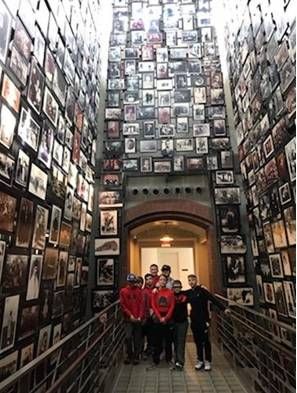
At the Holocaust Memorial Museum in Washington, a group of students stands on a walkway that passes through a three-story gallery of photos of Holocaust victims.
File photo
Click here to subscribe today or Login.
“When evil darkens our world, let us be the bearers of light. When fists are clenched in self-righteous rage, let our hands be open for the sake of peace. When injustice slams doors on the ill, the poor, the old and the strangers, let us pry the doors open.”
Spoken softly by a small crowd at a Misericordia University Holocaust Remembrance Service in 2019, that prayer befits our moments, our lives, and our world this Wednesday, Holocaust Remembrance Day.
At that service, Wyoming Valley’s own Rabbi Larry Kaplan began reading Holocaust victim names, but paused. He realized the list before him included one bit of information worth sharing, so along with a name, he gave an age.
“One … four … eight … seven …”
They pierced the heart like tiny darts. How could the world let infants and children die for no reason beyond sheer, blinding hate? How did humans ever become so inhuman that gassing people by the millions, from tots to septuagenarians, felt acceptable to the souls of those rounding them up, herding them like cattle in filthy packed train cars to cruel concentration camps and either killing them outright or working them to death?
Those shipped to camps left almost as much tragedy behind. In 2012 the Wilkes-Barre Jewish Community Center hosted Tikva Jeral, a 70-year-old barely tall enough to see over the podium. She recounted her own story, pieced together over many years, of surviving terror that swept her family into a Jewish ghetto in Kaunas, Lithuania.
Parents hid her in a secret bunker when Nazis came to collect children. Two months before her third birthday, they drugged her into silence, wrapped her in a blanket and smuggled her under barbed wire to a Catholic woman, herself an orphan, named Broneslava. “Brone” and her husband Adamos put the child in a bike basket and headed home.
Tikva survived the Holocaust. Her family did not. When Russia liberated Kaunas, retreating German soldiers scorched the ghetto, her father and mother dying huddled in the bunker where they had hidden their daughter before hatching the daring plan of Tikva’s salvation.
The children not so “lucky?’ In 2005 Robert Fischi flashed images of his cousin Sonja on a screen at the Jewish Community Center for a presentation to area high school students. Born in the Czech Republic one month after Sonja, he and his family managed to escape as Nazis came. Sonja, her older sister, mother and grandmother didn’t.
Caged at Terezin for two years — a camp infamous for being bogusly presented to the west as a model of how well Jews and other prisoners were treated — Sonja created pictures: Flowers, rare in her real world, proved abundant in the imagined one created by her and other imprisoned children. A tiny stick figure stood by a wooden frame that, in reality, served as gallows save when the Red Cross visited and Nazis morphed it into a soccer goal. A bucolic river in the childish drawings sported a gray blotch spreading downstream: the ashes children dumped by order of their overlords, cremated remains of those who died in the camp.
These stories alone offer ample reason to keep the horror of the Holocaust in memory. But now, having seen white supremacy and hate groups grow, watched violence burst out in our streets, and endured a hate-filled insurrection on our federal government, the demand is palpable, urgent, essential.
Never forget.
— Times Leader




